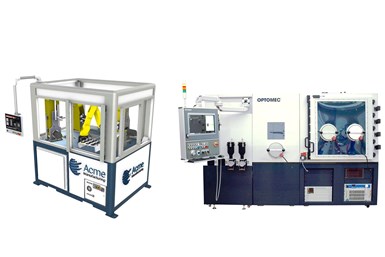Optomec, Acme Manufacturing Collaborate on Fully Automated Work Cell
Said to be the industry’s first fully automated work cell for the additive repair of turbine parts, the turnkey solution includes seamless integration of preparation, additive repair and finishing functions.
Acme Aerospace blade repair system and Optomec’s CS250 TBR atmosphere-controlled, 5-axis system. Photo Credit: Optomec
Optomec Inc., a 3D metal additive manufacturing (AM) solutions provider, and Acme Manufacturing, a provider of robotic material removal systems, have partnered to produce an industry first, a fully automated work cell initially optimized for repairing aviation compressor blades made of titanium.
The turnkey work cell is the product of a two-year collaboration between the companies, working with input from commercial maintenance repair and overhaul (MRO) and U.S. Department of Defense repair centers for aircraft engines. The cell includes an Acme aerospace blade repair system and Optomec’s CS250 TBR atmosphere-controlled, 5-axis system.
The automated work cell has a repair capacity of 85,000 titanium compressor blades per year and is said to provide a compelling ROI when compared to traditional CNC machines and manual TIG welding. Technologies used in the automated work cell, are commercially available today and have been certified by civil aviation authorities around the world.
The entry-level work cell consists of three stations that enable blade tip grinding, 3D additive laser cladding and postclad finishing. The cell also includes an automated pallet load/unload station, a pallet flipping station and a robotic material handling system. Each machine in the work cell is capable of automatically adjusting tool paths to accommodate blade-to-blade variations resulting from normal wear and distortion during service.
The Optomec CS-250 5-axis laser cladding machine will be used to produce high-quality, high -yield precision welds for titanium compressor blades utilizing LENS Directed Energy Deposition (DED) and AutoCLAD advanced vision and adaptive tool-pathing technology in a controlled argon atmosphere.
The Acme Manufacturing MRO blade tip repair machines can be configured for blade tip grinding, weld blending and polishing. The system is equipped with the first of its kind auto path generation, that enables a high-mix, low-volume environment. This technology is 3 to 4 times faster than traditional CNC machines.
Working in tandem, the systems in the work cell are said to provide a productive real-world implementation of Industry 4.0 and digital thread concepts.
Related Content
-
DMG MORI: Build Plate “Pucks” Cut Postprocessing Time by 80%
For spinal implants and other small 3D printed parts made through laser powder bed fusion, separate clampable units resting within the build plate provide for easy transfer to a CNC lathe.
-
Savage Automation Delivers 3D Printed Commercial Manufacturing Aids
The company's approach to designing end-of-arm tooling and other devices has evolved over the years to support longevity and repairs.
-
BMW Expands Use of Additive Manufacturing to Foster Production Innovations
The BMW Group is manufacturing many work aids and tools for its own production system using various 3D printing processes, with items such as tailor-made orthoses for employees, teaching and production aids, and large, weight-optimized robot grippers, which are used for such things as carbon fiber-reinforced polymer roofs and entire floor assemblies.
















